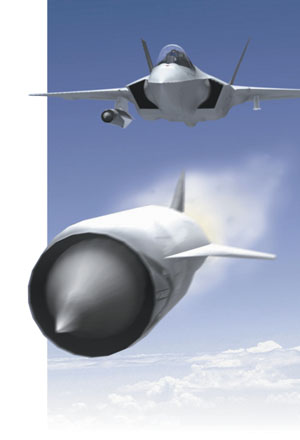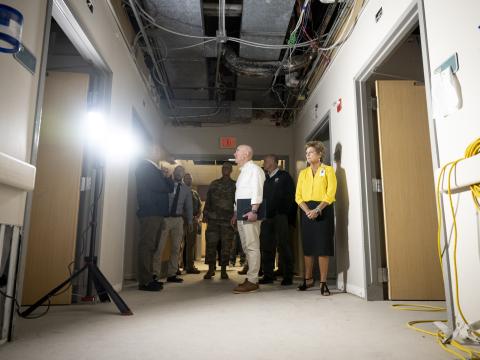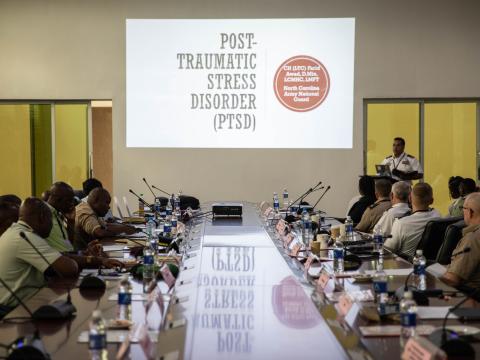Missiles Aim for Mach 4 Capability
Development team will test the high-speed system starting next fiscal year. 
Concept art illustrates what the Revolutionary Approach to Time-critical Long Range Strike (RATTLRS) might look like from a fighter jet platform. RATTLRS weapons will reach speeds of at least Mach 3.
A demonstration technology program underway is developing
The U.S. Department of the Navy, Office of Naval Research,
The project now is in phase three, with contracting company Lockheed Martin, out of the Palmdale,
Most weapons systems today operate mainly at subsonic speeds. A major requirement for RATTLRS during the flight testing, which is scheduled for fiscal year 2007-2008, is for the system to have a minimum speed threshold of at least Mach 3 and above. “The goal is for this system to be able to demonstrate a Mach 4 capability,” says Lawrence Ash, program manager for naval aircraft systems and weapons systems at the Office of Naval Research.
Other aircraft can fly at supersonic speeds, but RATTLRS does not require an afterburner to boost to Mach levels. Ash says that one of the key technologies in the new system is the ability to reach Mach speed using a high-speed turbine engine without a booster.
In a flexible system such as RATTLRS, users can make decisions about speed, range and fuel consumption to determine the best programming for a particular mission objective. In supersonic mode, the turbine engine used in RATTLRS is the most efficient and most cruise-speed-flexible propulsor. “The throttle ability really allows a different dimension of warfighter capability,” Ash says.
Having the ability to fly at a range of speeds depending on the programmed directions also sets the weapons system apart from others, which fly only at the top speed they can reach. RATTLRS will have the ability to operate from Mach 1 through 4 and at subsonic levels. For long-range lethality, RATTLRS can maintain a speed in the higher Mach range. Lockheed Martin developed the D-21, which used ramjet propulsion technology, but it could only operate on a single Mach number design. “That is not a very flexible system,” says Craig Johnston, Lockheed Martin program manager for the RATTLRS project.
According to project developers, the tough part of making a system such as this is not in making it fast but in making it flexible. Ash explains that the warfighter is not looking for a niche weapon but for one that has the right capabilities and can be moved easily.
RATTLRS has a variety of features that make the weapon unique as well as flexible. In addition to being able to attain supersonic speeds, the system can carry many different payloads and be launched from various platforms. “Warfighters desire to have ubiquitous firepower,” Ash says.
Another advantage of RATTLRS is that it can fly at high altitudes, making it harder for the enemy to engage. The combination of high-speed, high-altitude flight gives the system a greater survivability rate. In addition, the weapon’s signature is difficult to detect by enemy radar.
 |
| RATTLRS, the flexible weapons system shown here in concept, will be able to fly at supersonic or subsonic speeds and deliver munitions from a vertical launch platform. Lockheed Martin is the developer of the system. |
Researchers are trying to eliminate or reduce any new logistics or special fittings such as material or stowage on RATTLRS to allow more leeway with different platforms. The combination of speed and launch platform flexibility gives RATTLRS a range of attack capabilities and makes it tactically responsive. It can go from launch to altitude to kill over a long range in a short time frame. Fighter or bomber aircraft carrying the payload in an area near an objective could strike the target in minimal time after receiving intelligence or orders. According to
RATTLRS can strike quickly from an existing platform inside or outside of the engagement area, which is an important function in the current world situation. In the global war on terrorism, high-value targets often move frequently to new locations. Current technologies take hours for a weapon to be programmed and launched and to reach the objective. RATTLRS turns hours into minutes. “It could be launched in the order of two to five minutes,”
Not only would RATTLRS give
The system also has the ability to carry submunitions. Because RATTLRS can throttle, submunitions can be delivered at either subsonic or supersonic speeds. According to Ash, a variety of warheads in sufficient sizes can be delivered by RATTLRS to an intended target.
The supersonic speed potential of RATTLRS increases the velocity of the missiles exponentially, creating a higher kinetic energy.
Ash explains that warfighters in different areas and with different objectives need different weapons capabilities. The RATTLRS development team is trying to satisfy the various needs of troops with one system. The platforms and procedures used by troops give them multiple ways of conducting strike operations. The RATTLRS range of advantages—responsiveness, lethality, survivability and flexibility—gives the warfighter a weapon to use in multiple operational situations.
Before the demonstration weapons system becomes an operational tool for troops, it must finish its development cycle and then the acquisition community will make decisions on bringing it to fruition. The RATTLRS flight test plan calls for at least three flight demonstrations. During the system’s flight tests, researchers will program a test trajectory loaded prior to launch. RATTLRS will then navigate essentially autonomously and stop when it runs out of fuel at the test location.
After RATTLRS has gone through the demonstration and development period, acquisitions personnel will make the final definitions on the system, which can include the system’s size and shape and whether it will be a fly-and-forget program or another configuration. The intent of the development team is not to develop a system to transfer directly to the warfighter. The flight demonstrations to be conducted in the coming years will demonstrate that the technology has been brought to a readiness level, a sign to the acquisition community that the system is mature enough to consider, Ash says.
Web Resources
Office of Naval Research: www.onr.navy.mil
Lockheed Martin: www.lockheedmartin.com
National Aerospace Initiative: www.dod.mil/ddre/nai_home.htm
Alaska Aerospace Development Corporation: www.akaerospace.com



